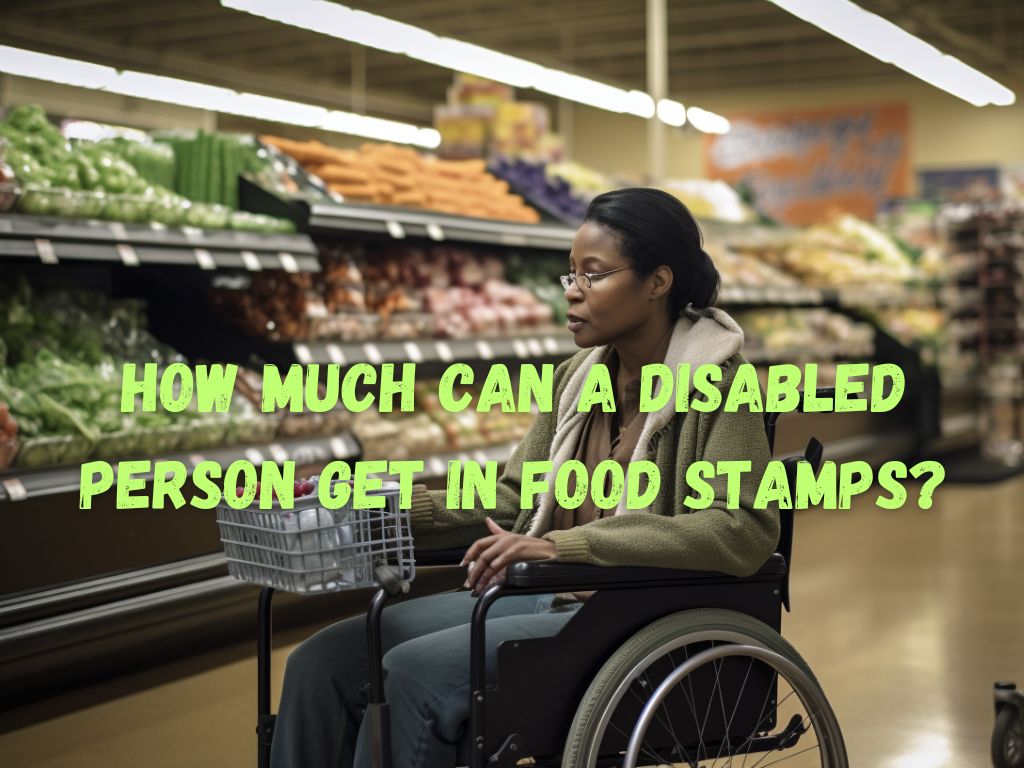The road to a full stomach isn’t always straightforward, especially for individuals dealing with disabilities.
For disabled folks in America, the Supplemental Nutrition Assistance Program (SNAP), also known as food stamps, plays a key role in ensuring food is available.
But, do you know how much can a disabled person get in food stamps?
This article will look at who is eligible for food stamps and how much a disabled person can receive.
Understanding Food Stamps and the SNAP Program
The Supplemental Nutrition Assistance Program, or SNAP, is a federal aid strategy in the U.S. It helps put food on the table for many low income individuals and families. This includes disabled individuals.
For SNAP purposes, a person is considered disabled if they receive federal disability or blindness payments. The program offers a lifeline to disabled individuals, giving them access to better nutrition and boosting their health.
Determining Eligibility
SNAP isn’t a one-size-fits-all program. Eligibility rides on several factors. These include income, resources, and household size.
The SNAP program views income and resources differently for disabled people than for others. In this program, the term “resources” encompasses items like bank funds and cars.
To be eligible, disabled individuals must meet specific income and resource limits. Household size and the status of other members play a significant role too.
Also, the program uses immigration status as a criterion. Citizenship or a suitable immigration status is required.

How Much Can a Disabled Person Get in Food Stamps?
The amount of SNAP benefits a disabled person receives depends on a combination of factors, including their individual income and expenses, as well as the number of people in their household.
The USDA sets maximum monthly benefit amounts for each household size. This means that the greater the number of people in a household, the higher the potential SNAP benefits they may receive.
However, it is important to understand that the disability status of a SNAP recipient does not guarantee they will receive the maximum benefit for their household size.
SNAP benefits for disabled persons are influenced by both their net income and their expenses. The program compares the household’s net income to the poverty line, taking into account deductions for necessities like housing and childcare.
Disabled persons can receive additional deductions, such as higher medical expense deductions, which lower their net income and may increase their SNAP benefits.
It is useful to refer to the USDA’s online tool called the SNAP Benefit Calculator to estimate the benefit amount for disabled individuals.
You can find the calculator by visiting the USDA website, and it should offer a snapshot of the potential benefits based on the details you provide.
How to Apply for Food Stamps as a Disabled Person
Collecting Necessary Documentation
Before starting the application process, disabled individuals should collect all relevant documents to verify their information in the application.
This documentation includes federal disability benefit letters, Social Security disability documentation, and any other disability payment proof.
Additionally, gather proof of income, bank statements, vehicle registration, and any other resources that may impact eligibility. It is also necessary to show housing and utility costs, childcare costs, and medical expenses.
Tips for a Successful SNAP Application
To reduce the chances of application errors, it is worth noting a few helpful tips. First, fill out the application form accurately and honestly.
If any information is unclear, finding outside help or contacting the SNAP office is a wise decision.
Second, keep all documentation organized and in one place for easy access during the application process.
Finally, track the application progress and respond promptly to any requests or updates from the SNAP office.

Managing Food Stamps: Using and Maintaining Benefits
Moving Beyond Basic SNAP Usage
SNAP benefits have a convenient usage method, the Electronic Benefits Transfer (EBT) card, which can be used at authorized food retailers.
Besides the traditional locations like supermarkets and convenience stores, SNAP recipients can sometimes utilize their benefits at special programs like Meals on Wheels or in some cases, ineligible people getting hot prepared meals at authorized SNAP restaurants under certain circumstances.
Maintaining and Maximizing SNAP Benefits
To maintain SNAP benefits, recipients are required to go through the recertification process periodically.
You can prepare for this process by keeping personal and financial records up to date and responding promptly to any communication from the SNAP office. This will help ensure that benefit interruptions do not occur.
Furthermore, it is beneficial to learn about additional programs or initiatives available for disabled individuals, such as nutrition education or access to fresh produce at farmers’ markets using SNAP benefits.
These programs can help maximize the positive impact of food assistance on health and well-being.
Common Mistakes & Misconceptions
Misunderstanding can cause eligible people to miss out on their rights. It’s common to come across misconceptions. One is that disabled people automatically get the maximum SNAP benefits. That’s not true. The amount of food stamps depends on the income and expenses of each household.
Applying for SNAP benefits needs precision. It’s essential to avoid mistakes. Such errors might lead to applications being rejected.
Errors could be as simple as missing information on the application form. It’s best to double-check all the details and ensure accurate completion.
Frequently Asked Questions
Can someone receive SNAP benefits if they’re on other aid programs like SSI?
Yes, individuals receiving SSI can still apply for SNAP benefits. However, their SSI income will impact their total SNAP benefit amount.

Do all disabled persons qualify for the maximum SNAP benefits?
No, the benefit amount is specific to each household’s net income, size, and expenses. Disability status does not guarantee maximum SNAP benefits.
How often should a disabled person renew SNAP benefits?
Benefit renewal frequency depends on the state, but the redetermination process typically occurs every six months to a year.
Are there any specific requirements for disabled people in SNAP?
Yes, disabled individuals should provide proof of their disability and may be eligible for additional deductions to determine net income.
Conclusion
Navigating through life isn’t always easy, especially for disabled individuals. Food is a vital necessity, and ensuring regular meals shouldn’t add to life’s challenges.
The SNAP program provides an essential lifeline. It is arguably one of society’s most robust threads, connecting the disabled with a path to food security.
Disabled people don’t receive a flat figure in food stamps. The amount varies, depending on unique factors in everyone’s lives. It’s crucial to understand the application process and eligibility criteria.
This helps disabled individuals maximize the benefits they acquire. SNAP is an empowering program, creating a safety net for disabled folks in America.


 Tags:
Tags:










